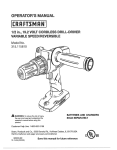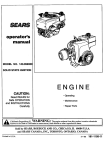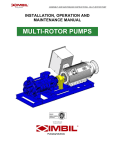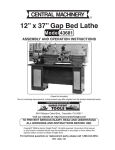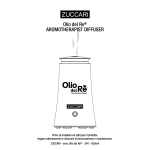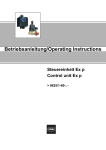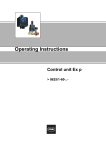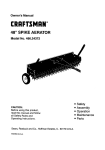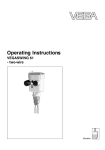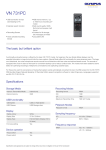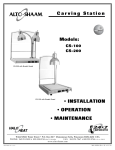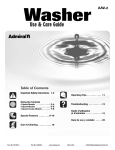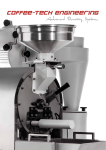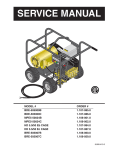Download VIBER X1™ Manual - VMI International AB
Transcript
Vibration Measurement Instruments Vibration Measurement Instruments Vibration Measurement Instruments VIBER X1™ Manual VIBER X1™X1™ Manual VIBER Manu ment Instruments ER X1™ Manual Ver. 1.4 Vibration Measurement Instruments Our X series of hand-held instrument VIBER X1 VIBER X2 VIBER X5 VIBER X3 Vibration Measurement Instruments Important information Important information Safety precautions Vibration measurement and balancing involves measurement on rotating machines. away from parts rotating transducers and cablescables from Keep a safe distance to rotating andparts. secureSecure transducers and transducer rotating parts.parts. Always followfollow company, locallocal and and national security regulations! from rotating Always internal, national security When working withworking weightswith on the rotor, on always follow “locksecure out tagthe out” proceduregulations! When weights the rotor always start res. Secure start switch with lockemergency and also use the emergency switch This for douswitch with the a locker and also useathe switch for double safety. is ble safety. important This is especially important the machine is remote controlled. VMI especially when the machinewhen is remote controlled. International AB takes no responsibility for any on people and machines. VMI International AB takes no responsibility foraccidents any accidents on people and machines. VMI International AB and our authorized dealers will take no VMI International AB and our authorizedand dealers takeresult no responsibility for damages on machines plantswill as the responsibility for damages on machines and plants as the result of the use of VIBER X1™ measurements. of the use of VIBER X1™ measurements. Even though great efforts are made to make the information in Even thoughfree great efforts areand made to make information in this manual from errors to make thethe information this manual free from errors and to make the information complete for the user, there could be items we have missed, complete user,amount there could be items we missed, because offor thethe large of information. Ashave a result of this, because of the large amount of information. As a result this, we might change and correct these items in later issues of without we might change and correct these items in later issues without further notice. Also changes in the VIBER X1™ equipment may further notice. in the of VIBER X1™ equipment may take place that Also affectchanges the accuracy this information. take place that affect the accuracy of the information. 3 Vibration Measurement Instruments Instrument overview Instrument overview The VIBER a portable vibrometertotobe be used used in The VIBER X1™X1™ is a isportable Vibrometer in prevenpreventive and pro-active maintenance work, especially tive and active maintenance work, especially on rotatingon machinery. rotating machinery. A complete set consists of an instrument, carrying bag, a vibration transducer with magnet support and A complete set consist of an instrument, carrying bag, a vibration charger. VIBER X1™ measures the velocity (mm/s RMS) transducer magnet support charger. in the with frequency range 2 Hz –and maximum frequency. The VIBER X1™ is measuring the effective velocity RMS) instrument has the capability to measure up to 40(mm/s kHz, the in thelimiting frequency range – maximum frequence. The range can be factor is the2 accelerometer. The accelerometer proviset byded adjustable filters,X1 high pass fiup lters cankHz. be set Hz or 10 Hz, with the Viber measures to 15 The2frequency range can be setbe byset adjustable pass filters can be low pass filters can at 1 000filters. Hz orHigh maximum frequency. set to 2covers Hz or 10 Hz.of the frequencies that will occur for the This range most Lowofpass filters can failures be set at and 1000imperfections. Hz or maximumExamples frequency.are majority mechanical This range covers most of the frequencies that will occur for gears, unbalance, looseness, resonance, misalignment of shafts and the majority of mechanical failures and defects. Examples are cavitations and other fluid generated vibrations. unbalance, looseness, resonance, misalignment of shafts and The judgements of the are supported gears, cavitation andmeasured other fluidlevels generated vibrations. by several vibration standards. The close comparison between vibration The vibration alerts are supported by several vibration stanlevelsdards. and actual wear of the machinery will build up local The close comparison between vibration levels and knowledge. This experience should be your usedknowledge. to optimiseUse the type of actual machinery wear will build up experience to higher determine the actionare required actionthis required when vibrations found.when high vibrations are found. A common standard for vibration ISO A common standard for judgement of vibrations is ISO is10816-3 10816-3 and may be available from domestic standardisation and may be available from domestic standardisation authority. authority.is an upgrade of older standards that has been in use This standard This standard, in use for decades worldwide, is an upgrade for several decades and has a worldwide acceptance as a and excellent for continuous and long lasting operation of good judgement for continuous and long lasting operation of machinery. machinery. 4 Vibration Measurem ent Instruments Vibration Measurement Instruments Vibration Measurement Instruments Functions Functions Functions Power the instrument StartStart ofon the oftinstrument the instrument St ar of th e instrument Prstart esthe s thkey e staand rt ke y an PressPress the the instrument tostarts measure On/Off key and the instrument to meastart key and the instrument to measure d th e in strstarts umenstarts t starts to measure vi br at io n, de sure vibration, default Hz –immaximum frequency vibration, default is fa 2 ul –istmaximum frequency range, diodes vibration, default 2is –2ismaximum frequency range, the diodes –2m ax um frequency the indica rafilter nge, the diodes teand sLED’s lohigh range, the the low and high pass w anindicate d high indicates low pass fi lters indicates low and high pass fisetting. lters setting. pa ss filters setting. The inThe strwill setting. instrument shuts offautomatically automatically afterapproximately um enbe t wshut ill The instrument off after after approximately The instrument will bebe shut off shautomatically ut of f au tom atically after approx 4 minutes if no approximately minutes if no keys are pressed. imatel keused yare 4 minutes if no ifkey therintime. 4 minutes noare key arused eduring usedduring du gthe thetime. time. Improving theinlight Improving light Increase display brightness Impr ov gthe th e light This button can be This Use button can be used ifusthe digits need anehigher brightness to beto be This button can beincrease used the need a higher brightness edifif this button to display brightness. thedigits di gits ed a higher brightne more visible. ss to b moremore visible. visible. Changing rangerange Changing frequency C hangfrequency ing fr equency range Th e Vi The Viber X1™ ison one ofanalogical few analogical analoginstrument instrument availaber XX1™ 1™ isis The Viber X1™ is one of that has The Viber one of instrument that has efew of fefew w an alogicUse al instr ad ble with adjustable frequency ranges. the up/down ju um sta en bl t that has e fre qu enranges. cy raranges. adjustable frequency measure in other frequency adjustable frequency To measure in other frequency ngTo es . easure in otup to change the filters. To ThemLED lights tofreshow raarrows ng he e, us rThe e up/down qu th ency e up /dow range,range, use the arrows to change the fithe lters. fiThe lters use the up/down tochchange filters. filters nthis ararrows ro w s to an the filter in use. Use to compare measurements ge th LED will light up e fi lte rs . Th e fi lte rs to LED LED will light up to show the fi lter in use. This can be a useful will light up to show the fi lter in use. This can be a useful sh ow th filteISO r in us the range. Note: thee old standard e. This had fein atur cain e; same n 10 cocomparison be mpariscan a us ef on ul feature; comparison be done with measurements the feature; can be done with measurements in the ca n be do Hz as frequency range.neWe recommend to with measuremyou sa-1000 me rang en ts10in-1000 e. NNotice th otHz e ic easththe samesame range. Notice that old ISO standard had 10 -1000 Hz range. that the old ISO standard had Hz atstandard th e use 2 – 1000 a range. ol d ISO standard ha as frequency range. 000Hz Hz as frequency range.range. WeW recommend useto2use – d1000 Hz as frequency We recommend you 210– -1 1000 e reco mmenyou d yoto u to use 2 – 1000 H as a standard rang z e. as a standard range.range. as a standard 5 Vibration Measurement Instruments Vibration Measurement Instruments Vibration Measurement Instruments Battery check Battery Battery checkcheck VIBER a battery check. thanless 10than % 10 % VIBER X1™ X1™ features has an embedded batteryWhen check,less when VIBER X1™ an embedded battery check, whenthan less than 10 % VIBER X1™capacity has anhas embedded battery check, when of remains, battery LED will flash. of the the battery battery capacity remains, the the battery LED will less flash. 10 % the battery capacity remains, the battery LEDflash. will flash. of the of battery capacity remains, the battery LED will Bearing condition Bearing condition Bearing condition Press this symbol key and the measurement of bearing condition Presssymbol this symbol key the measurement of the bearing condition Press this key and theand measurement of bearing condition Startstart. measuring vibration on the machine then press symbol will The instrument measures instantaneously a bearing will start. The instrument measures instantaneously a bearing will start. The instrument measures instantaneously a bearing key for bearing condition measurement. meacondition value in the range between 500The Hz instrument to 20.000 Hz. condition value the range between 500 Hz. condition in the ain range between 500 Hz to Hz 20.000 Hz. sures Bearing Condition value in to the20.000 range To go instantaneously backvalue to vibration measurements, press the symbol once To go back to vibration measurements, press the symbol once To go back to vibration measurements, press the symbol once between 500 Hz to 16 000 Hz. more. more. more. To return to vibration measurement, press the symbol again. Placing of the measuring point Measuring point location Placing the measuring Placing of theof measuring point point Measurements should be taken on the bearing housing The measurements beand taken as close tovertical the bearing or as close asshould possible in on theor horizontal, and as The measurements be on taken onclose or as to close the bearing as The measurements shouldshould be taken or as the to bearing as possible and in horizontal, vertical and axial directions. axial directions. possible in horizontal, vertical anddirections. axial directions. possible and inand horizontal, vertical and axial V V 6 Vibration Measurement Instruments How toHow make good measurements to make good measurements The sensitivity direction the transducer coincides The sensitivity direction of theoftransducer coincides withwith the the center axis of the transducer. Use the built in centre axis of the transducer. The transducer end (withmagnetic the mount by gently placing the accelerometer onto the meamagnetic support) is pushed firmly against the measurement surement point. Wait a few seconds for the accelerometer point. The main purpose is to make the complete transducer to to come toina the steady state of to the reduce unwanted noise. youto fully participate motion measurement point.IfTry are connecting to a non-magnetic surface, push firmly hold the transducer in a vertical, horizontal or axial direction as against measurement point. Make surehave you have possible, eventhe if the machine surface does not thesegood contact with the machine. It you are measuring on a curved directions. Read the instrument held with the free hand. Note a surface, make sure the accelerometer is attached and not stable reading as well as a fluctuating one, since the fluctuation moving back and forth. Attach the transducer in a vertiitself is valuable information regarding the reason for the cal, horizontal or axial direction, if possible. Note if the vibration. reading is stable or fluctuating. The non-stable reading is also valuable information used to determine the vibration When the transducer is mounted with the magnet the frequency cause. range of the measurement is reduced to about 2 000 - 3 000Hz depending onthe thetransducer flatness ofisthe measuring surface. When mounted with the magnet, the frequency range of the measurement is reduced to about 2000 – 3000 Hz depending on the flatness of the contact Note! between magnet and surface. When using the magnet the bearing condition value can be Note! changed. substantially Using magnet can change the bearingcause condition value. Vibrations at the high frequencies can sometimes measurement High frequency vibration can sometimes be difficult to collack of confidence. Pressing the transducer more firmly should lect because high vibration does not transmit through the not change the reading. If in doubt, always try to adjust the machine for long distances. Pressing the transducer more contact point first. Secondly, if necessary, mount the transducer firmly should not change the reading. If in doubt, always with the stud. the contact point first. Secondly, if necessary, tryM6 to adjust mount the transducer with the M6 stud. All normal measurements on vertical or horizontal machinery 7 axes of true vertical, should follow the three perpendicular Vibration Measurement Instruments horizontal and axial directions. The reason or is that you should keep All normal measurements on vertical horizontal to themachinery main stiffness directions caused by normal non should follow the three perpendicularsymmetrical axes of properties of the supports etc. It will result in true vertical,foundation, horizontal piping, and axial directions. better understanding if the basic measurements are made in this way. The VIBER X1™ is mainly intended for measurements against the machinery housing and bearings to compare to standards. The VIBER mainly intended measurements against VIBERX1™ X1™iscan also be used tofor measure other compothe housing and bearings of machinery according to the intentions nents such as piping, valves, etc. of the standards. You can also use it to measure other parts such as piping, etc.cases, Notethe thatmass in some cases the mass of the Note:valves, In some of the transducer may transducer may infl uence the reading. A good rule is to consider influence the reading. A good rule is to avoid readings readings on surfaces aretimes lowerlower in mass than 10 the mass on surfaces thatthat are 10 in mass of times the transof theducer. transducer. 8 Vibration Measurement Instruments How How to interpret vibration measurements to interpret vibration measurements A user with no previous experience, should use the ISO A user10816-3 with nostandard. previous experience to interpret the results is recommended to use the ISO 10816-3 standard. The standard normally calls for a velocity measurement The standard a measurewhat in velocity based on in mm/snormally RMS. Tocalls betterforunderstand this meamm/ssurement RMS. Tomeans, better understand what this measure means think of it as how fast the machine it can be helpful to consider the reading as measure a mean value the back and is moving back and forth. This givesofa good forward motion. This measure gives a good understanding understanding of the amount of “break down energy”,of the amount of “break down energy”, causing mainly wearorand causing mainly wear and fatigue in the machine thefatigue work,structure. in the machine or the structure being measured. The instrument is measuring thethe total RMS-value of thevalue vibration The instrument measures total RMS vibration in actual frequency range. This RMS-value is an average sum of in the frequency range. This RMS value is the average all thesum measured vibrations. of all the measured vibrations. Example: Example: If the simultaneous vibration caused by unbalance is If the(4mm/s), simultaneous vibration caused by unbalance is (4mm/s), by by misalignment (2 mm/s) and by the gear misalignment (2 mm/s) and by the gear mesh (5 mm/s) then the mesh (5 mm/s) then the total vibration measured with total vibration measured VIBER X1™ is 6.7 mm/s. VIBER X1™ is 6.7with mm/s. 4 +*24*+22+*52*+55=*6.7mm Total Total vibration = √4=* √4 vibration 5 = 6.7mm Notice that athat reduction of theofunbalance from from 4 mm/s to 1 mm/s Notice a reduction the unbalance 4 mm/s to will reduce the total value from 6, 7 mm/s to 5, 5 mm/s. 1 mm/swill reduce the total value from 6, 7 mm/s to 5, 5 mm/s. 9 Vibration Measurement Instruments Vibration Measurement Instruments The ISO standard isisclassifying the machinesdifferently differently if the TheThe ISOISO standard classifying standard classifies the the machines machines differently ifif the the machines are considered as fl exible or rigid mounted. This reflects machines are considered exibleThis or rigid mounted. This refl machines are flexibleas orflrigid. reflects the location ofects thethelocation of the machines stiff-body resonance’s related to location of the stiff-body machines stiff-body related thethe the machine’s resonance resonance’s related to the basicto runbasic running speed of the machine. basic running the machine. ning speedspeed of theofmachine. For instance, aamachine supported by rubber rubber springs have For instance, machine supported by ororsprings have For example, a machine supported by rubber or springs resonance’s lowrunning running speeds. machine resonance’s atatlow The machine startsvibrate vibrate have a resonance at lowspeeds. runningThe speeds. Thestarts machine certain lowrpm. rpm. When the speed speed isisthe increased above these startslow vibrate atWhen a low the rpm. When speed is increased at at certain increased above these resonance frequencies the vibration vibration isis reduced. This abovefrequencies these resonance frequencies, the vibration ismachine redu- is is resonance the reduced. Thismachine considered exible. ced. This machine is considered flexible. considered flflexible. Resonance easilybe found when a flexible machine isis is resonance caniseasily easily be found when aaflflexible machine AA resonance can found when exible machine running updown or down in speed. resonances are located at running up or in speed. The The resonances are located running up or down in speed. The resonances are locatedat at speed where the vibration a local maximum the the rpm´s where the vibration has ahas local maximum level.level. the rpm´s where the vibration has a local maximum level. 10 Vibration Measurement Instruments Modern machines often run at high speed and bearing-supports Modern machines often run at high speed and bearingare flexible, foundations should/can be evaluated as flexible, even supports are flexible, foundations should/can be evaluawhen it is not mounted on rubber or springs. ted as flexible, even when it is not mounted on rubber or springs. The ISO 10816-3 standard allows for slightly higher limits when a foundation is considered flexible than when if it is rigid. The ISO 10816-3 standard allows for slightly higher A conclusion from this is also that a resonance condition in limits when a foundation is considered flexible than principle is not allowed or at least must be avoided at operating rigid. A conclusion from this is a resonance condition speeds. In practice this also includes the double speed as well as should not be allowed or at least must be avoided at any other natural excitation frequency such as blade passage etc. operating speeds. In practice, this also includes the double speed as well as any other natural excitation A great advantage with proper vibration measurements and the frequency such as blade passage. use of vibration standards is that you can judge the future maintenance cost reliably already at first start-up. If you find A great advantage with proper vibration measurements levels above 3 mm/s RMS, you can be rather sure that the machine and the use of vibration standards is that you can judge will cause increased activities in maintenance. the future maintenance cost reliably at start-up. If you The specific cost and action is of course individual to the find levels above 3 mm/s RMS, it’s a risk that the machmachine design. ine will have higher maintenance cost. The specific cost and action is specific to the machine design. The next logical step is therefore to apply more advanced analyzers like VIBER X2™, X3™ or X5™ to learn the frequency The next logical step if you want to improve the acbehind the vibration and thus the exact mechanical fault. curacy of measurements is to use more advanced The practice of this is beyond the scope of this manual. analyzers like VIBER X2™, X3™ or X5™ to learn and detect the frequency behind the vibration and thus the exact mechanical fault. The practice of this is beyond the scope of this manual. 11 Vibration Measurement Instruments Recommended vibration levels in mm/s and Recommended vibration levels in mm/s and common fi ndings common findings The following is an extraction of part of the old standard ISO The following partmachines an extraction of the old standard 2372 classis4,in large on flexible foundations, withISO 2372 class 4, large machines on fladded. exibleUse foundations, with comsome common findings this simplified listsome as a first when approaching a newly commissioned machine mon fiindication, ndings added. or after some time in operation. Investigate the reason for any machineed that This simplifi listvibrates can be used, as a first indication, when above 3 mm/s RMS.newly commissioned or after some approaching a machine time in operation. • 0 – 3 mm/s Take as a rule to investigate the reason for any machine that viSmall vibrations - None or very small bearing wear. Rather brateslow above 3 mm/s RMS. noise level. • • 0 – 3 3mm/s – 7 mm/s SmallNoticeable vibrationsvibration - None levels or very wear.toRather aresmall often bearing concentrated some low noise specific level. part as well as direction of the machine. Visible bearing wear. Seal problems occur in pumps and increased noise Keep the machine under observation and measure • 3 level. – 7 mm/s at smaller time intervals than before to detect to a deterioration Noticeable vibration levels often concentrated some specific trend if any. Compare vibrations to other operating variables. part as well as direction of the machine. Visible bearing wear. Seal problems occur in pumps and increased noise level. Keep • 7 – 18 mm/s the machine under observation and measure at smaller time interLarge vibrations. Bearings running hot. Bearing wear-out vals than before to detect a deterioration trend if any. causes frequent replacements. Seals wear out, leakage of all Compare to other operating kindsvibrations evident. Cracks in welding andvariables. concrete foundations. Screws and bolts are loosening. High noise level. Plan action soonest. Do your best to discover the cause. You are wearing down investments quickly. 12 Vibration Measurement Instruments Vibration Measurement Instruments • 7 – 1818mm/s – mm/s • Recommended vibration levels in mm/s and Very large vibrations and high noise levels. This ismeasures detrimental the bearing symbol and the the bearing LargePress vibrations. Bearings running hot.instrument Bearing wear-out cause common findings to the safe operation of the machine. Stop operation if technicondition value. Seals wear out, leakage of all kinds evident. frequent replacements. cally or economically possible. Few machines can withstand Bearing condition value is foundations. RMSany value of all high frequency Cracks welding concrete Screws and bolts arevibraThe following is inand part an extraction of the old standard ISO thisinlevel without damage. Reduce further running time to 2372 tions in the range of 500 Hz to maximum frequency. loosening. High noise level. Plan action soonest. Do your best to class 4, large machines on fl exible foundations, with some coman absolute minimum. has the g (= down m/s²) investments quickly. revealfiThis the average reason. You are unit wearing mon ndings added. • 18 –edmm/s This simplifi list can be used, as a first indication, when condition Very large vibrations and high Bearing noise levels. This is symbol detrimental to Bearing condition approaching a machine newly commissioned or after some the safe operation of the machine. Stop operation if technically time in operation. or economically considering stop cost.that FewviTake as a rule to possible investigate the reasonthe forplant any machine Press the3bearing symbol. The instrument measuresReduce the machines can withstand this level without damage. any brates above mm/s RMS. Bearing condition value bearing condition Bearing minimum. condition value is the RMS further running time tovalue. an absolute value of all high frequency vibrations in the range of 500 Hz • 0bearing – 3 mm/s The condition This value in VIBER X1™ to maximum frequency. average has the unit gis an average value, SmallRMS vibrations None or very small bearing wear. Rather500 lowHz and value,-of all high frequency vibrations between noisemaximum level. frequency. Bearing condition value with the unit “g” because high frequenThis value is an average • – 7 mm/s cies3give a larger signal compared with velocity, if it is measured Noticeable vibration levels often concentrated This value is an average with the unit “g”. to some specific in acceleration. We use as acceleration because high frequencies a larger part as well direction of the machine. Visible bearing When the balls or rollers rotate inside the give bearing awear. wide-band signal compared to velocity, if measured in noise acceleration. Seal problems occur in pumps and increased level. Keep noise and vibration arises. This noise and vibration are increased When the balls observation or rollers rotate inside the bearing, a widethe machine under and measure at smaller time interif the bearing is poorly lubricated, overloaded due to misalignmen band noise and vibration occurs. This noise and vibration vals than before to detect a deterioration trend if any. or has a ifdamaged surface. increase the bearing is poorly lubricated, overloaded due to Compare vibrations to other operating variables. If the selectedorfrequency bandsurface. includes low frequencies, the misalignment has a damaged If the selected frequency includes low frequencies, the from bearing condition valueband would also include vibrations bearing condition value would also include vibrations from unbalance, misalignment, etc. and not only from bearing vibration unbalance, etc. and from bearing and wouldmisalignment, therefore be diffi cultnot to only interpret. vibrations. If the selected frequency band only includes very high frequency noise and vibrations we would need special vibration transducers 13 that are very rigidly and closely mounted to the bearing because Vibration Measurement Instruments Press the bearing symbol and the instrument measures the bearing If thevalue. selected frequency band only includes very high condition frequency noise andisvibrations, we of would needfrequency special vibraBearing condition value RMS value all high vibration transducers that are very rigidly and closely tions in the range of 500 Hz to maximum frequency. mounted to the bearing because the machine structure This average has the unit g (= m/s²) works as a mechanical filter for high frequencies. VIBER X1™ measures the bearing condition value between 500 Hz to 16 kHz. Normal machinery vibrations rarely have condition vibrations above 500Bearing Hz. Note! A high bearing condition value is an indication and a Bearing condition value recommendation to continue with other fault analysis. High bearing condition values can appear at gear boxes, The bearing condition value in VIBER X1™ is an average value, converting machines with cutters and similar machines RMS without value, ofany allbearing high frequency vibrations between 500 faults because they “naturally” pro-Hz and maximum frequency. duce frequencies above 500 Hz. This value is an average with the unit “g” because high frequencies give a larger signal compared with velocity, if it is measured in acceleration. When the balls or rollers rotate inside the bearing a wide-band noise and vibration arises. This noise and vibration are increased if the bearing is poorly lubricated, overloaded due to misalignment or has a damaged surface. If the selected frequency band includes low frequencies, the bearing condition value would also include vibrations from unbalance, misalignment, etc. and not only from bearing vibrations and would therefore be difficult to interpret. If the selected frequency band only includes very high frequency noise and vibrations we would need special vibration transducers that are very rigidly and closely mounted to the bearing because 14 Vibration Measurement Instruments Vibration Measurement the machine structureInstruments works as a mechanical filter for high Bearing condition value with unit “g” RMS frequencies. Bearing condition value unit RMS BearingX1™ condition value with with unit “g” “g” RMS value between VIBER is measuring the bearing condition The a guide to identify bearing 500 Hz to diagram 20 kHz. below Withinisthis frequency rangethe a common The above is the bearing condition condition value. vibrations other causes (e.g. flow The diagram diagram above isIfaevaluation a guide guide to to identify identify the bearing condition experience exist in the ofofthe bearing condition level. value. If vibrations of other causes (e.g. fl ow surge, gear are surge, gear mesh) are within in(e.g. the frequency value. Ifmachinery vibrations of other causes flow surge,range gear mesh) mesh) are Normal vibrations rarely have vibrations above 500 Hz. within in the frequency range 500 – 6400 Hz this can give a high 500 16frequency 000 Hz this can 500 give–a16 high within in–the range 000bearing Hz thiscondition can give a high bearing condition without the being damaged. value, withoutvalue, the bearing damaged. A high beabearing condition value, withoutbeing the bearing bearing being damaged. ring condition value can also indicated if the bearing A high bearing condition value canbealso be indicated if the bearing A bearing condition value can also be indicated if the bearing is poorly lubricated or overloaded. is high poorly lubricated or overloaded. Note! is poorly lubricated or overloaded. A high bearing condition value is an indication and a recommendation to continue with other fault analysis. High bearing condition values can appear at gear boxes, converting machines with cutters and similar machines without any bearing faults because they “naturally” produce frequencies above 500 Hz. 15 Vibration Measurement Instruments Bearing condition value with unit “g” RMS The diagram above is a guide Technical data VIBER X1to identify the bearing condition value. If vibrations of other causes (e.g. flow surge, gear mesh) are within in the frequency range 500 –Standard 6400 nom Hz100 this can(Adjusted givetoathe high Vibration transducer Accelerometer mV/g instrument) bearing condition value, without the bearing being damaged. Input amplitude range Vibration Max 20 g RMS With other sensor up to 200 g Max 20 gBC A high bearing condition value can also be indicated if the bearing Dynamic range 60 dB (159 Hz) is poorly lubricated or overloaded. Frequency range Bearing condition 2 - 1000 Hz 10 - 1000 Hz 2 - Max Hz 10 - Max Hz Vibration Bearing condition Vibration units 0.5 to 16 kHz g-value, mm/s Amplitude presentation Note 2 RMS Signal processing Accuracy Note 1 Analogous Vibration ±3% Note 3 Bearing condition ±5% Note 4 Battery Rechargable Lithium or NiMH (AAA) Note 5 Operating time Min 24 or 12 hours for a full charged battery pack Note 6 External charger 5,0 V Lithium or 7,5 V NiMH (AAA) LED display 7 segment Enclosure protection IP65 Operating temp. range -20 to 60°C Weight 285 gram Size (L x W x H) 125mm x 70mm x 40mm 16 Note 7 Vibration Measurement Instruments TECHNICAL SPECIFICATIONS VIBER X1™ Technical data VIBER X1 INPUT SENSITIVITY: 100mV/g calibrated at 156.15 Hz. Note 1. User selectable MEASURING RANGE: Velocity: 0-200 mm/s RMS Note 2. User selectable FREQUENCY RANGE: Total level 2-3200 Hz Adjustable filters: 2-10, 1000 - maximum Note 3. Full scale is 199,9 Hz mm/s for vibration. Bearing condition 500 Hz – 20 kHz Note 4. Over 0,05 gBC WEIGHT: 270 gram with accelerometer and Note 5. Capacity of batteries batteries is 2300 mA/h for lithium and 1100 mA/h NiMH. If using Thefor measurement mainlyalkaline follows ISO10816-3. batteries, never connect a charger to the ACCURACY*: instrument. Better than +/- 3 % * This value can(storage be higher, close-20 to the lters60 cut°C). off frequency. temp. to fimax Note 6. Operating times on intensity on the BATTERY TYPE: 3 pcdepends of AAA Rechargeable LED:s and type of batteries. Ca: 24 hours for Lithium and Ca: 12 hours for NiMH. VIBRATION TRANSDUCER* The accelerometer VMI 192 has a sensitivity 100mV/g +/-10%. Note 7. Instrument, including battery and transducer. MAGNET Obs.SUPPORT You should avoid using other accelerometers Length: Diameter:of15mm, Magnetcalibration. force: aboutIf14kg 20mm, because instrument you change the accelerometer, the instrument Note! must be calibrated to preserve the accuracy. You must avoid to use other accelerometers bacause of the calibration. If you change accelerometer the instrument must be calibrated to preserve the accuracy. 17 Vibration Measurement Instruments Vibration Measurement Instruments Technical specifications for VMI 192 Technical specifications for VMI 192 Sensitivity (+/-10%) 100mV/g Sensitivity (+/-10%) Frequency response 100mV/g (±3dB) 0.4–13000Hz Frequency response (±3dB) 0.4–13000Hz (±10%) 1.0-9000Hz (±10%)±80 1.0-9000Hz Dynamic Range g, peak Dynamic Rangeresonance ±80 g, 26000Hz peak Internal InternalSettling resonance 26000Hz time <2 Seconds SettlingBias timeVoltage <2 Seconds 10-14VDC Bias Voltage 10-14VDC Temperature range -50 to 121 °C Temperature rangeShock Protection -50 to 121 Maximum 5000°Cg, peak • We reserve the right to modify or improve the designs or Maximum Shock Protection 5000 g, peak Electromagnetic Sensitivity CE-Certifi ed specifications of our products at any time without notice. Electromagnetic Sensitivity CE-Certifi ed Weight (without magnet) 51 grams WeightDeclaration (without magnet) 51 grams Mounting stud M6 Adapter stud of conformity Mounting stud Torque M6 Adapter Mounting 2.7-6.8stud Nm Mounting 2.7-6.8 Nm in conformity with VMITorque declares that the Viber X1™ is manufactured • • We reserve national and the right to modify or improve the designs or cations of our or products at the anydesigns time without notice. Weinternational reservespecifi the right to modify improve or regulations. specifications of our products at any time without notice. The system complies with, and is tested according to, following requirements: Declaration of conformity EMC Directive: 2004/108/EC Declaration of conformity Low VMIVoltage declaresDirective: that the Viber X1™2006/95/EC is manufactured in conformity with national an 8international August 2011 VMI declares that theregulations. Viber X1™ is manufactured in conformity with national and international regulations. The system complies with, and is tested according to, following requirements: The system complies with, and is tested according to, following requirements: EMC Directive: EMC Directive: Low Voltage Directive: Low Voltage Directive: 2004/108/EC 2004/108/EC 2006/95/EC 2006/95/EC 8 August 2011 8 August 2011 Measurement Instrument International AB Vibration (VMI) Vibration Measurement Instrument International AB (VMI) 18 Vibration Measurement Instruments Warranty Warranty disclaimer disclaimer VMI VMI warrants warrants the the products products to to be be free free from from defects defects in in material material and and workmanship workmanship under normal use and service within two years from the date of under normal use and service within two years from the date of purchase purchase and and which which from from our our examination examination shall shall disclose disclose to to our our reasonable reasonable satisfaction satisfaction to to be be defective. defective. Warranty claimed products shall be returned prepaid to VMI for service. We reserve Warranty claimed products shall be returned prepaid to VMI for service. We reserve the the right right to to repair repair or or to to replace replace defective defective products. products.Always Always try try to to explain explain the the nature nature of rst all of any any service service problem; problem; by by e-mail e-mail or or telephone. telephone. Check Check fifirst all natural natural problems, problems, like like empty empty batteries, batteries, broken broken cables, cables, etc. etc. IfIf returning returning the the product, product, be be sure sure to to indicate indicate that that the the purpose purpose isis to to make make repairs repairs and and indicate indicate the the original original invoice invoice number number and and date of shipment. date of shipment. Warranty Warranty exclusions exclusions Damage Damage not not resulting resulting from from aa defect defect in in material material or or workmanship workmanship or or by by other other than than normal normal use. use. Damage Damage resulting resulting from from repairs repairs performed performed other other than than by by an an authorized authorized service centre. The limited two year warranty and remedies contained herein service center. The limited two year warranty and remedies contained herein are are in in lieu of all other warranties, expressed or implied including any warranty of merlieu of all other warranties, expressed or implied including any warranty of merchantability tness for chantability and and any any warranty warranty of of fifitness for aa particular particular purpose, purpose, and and all all other other remremeedies, obligations or liabilities on our part. In addition, we hereby disclaim liability dies, obligations or liabilities on our part. In addition, we hereby disclaim liability for for consequential consequential damages damages for for breach breach of of any any expressed expressed or or implied implied warranty, warranty, incluincluding any implied warranty of merchantability and implied any implied warranty of ding any implied warranty of merchantability and any warranty of fitness fifor tness for a particular purpose. The duration of any implied warranty which might a particular purpose. The duration of any implied warranty which might exist by exist by operation of law be to limited to one year date of original operation of law shall be shall limited one year from thefrom date the of original retail retail purchase. purchase. NOTE: NOTE: Some Some countries countries do do not not allow allow the the exclusion exclusion or or limitation limitation of of consequential consequential damages, and some countries do not allow limitation on how long damages, and some countries do not allow limitation on how long an an implied implied warranty warranty lasts, lasts, so so the the above above exclusions exclusions or or limitations limitations may may not not apply apply to to you. you. This This warranty gives you specifi c legal rights and you may also have other rights warranty gives you specific legal rights and you may also have other rights that that vary vary from from country country to to country. country. IfIf you you have have problems problems with with your your instrument instrument during during or or after rst contact after the the warranty warranty period, period, fifirst contact your your distributor distributor you you purchased purchased the the unit unit from. from. 19 VMI International AB Sweden • www.vmiab.com























